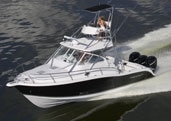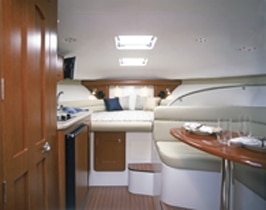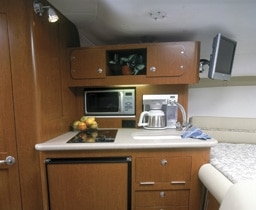
Pro-Line 35 Express

Pro-Line 35 Express

Pro-Line 35 Express
I need more hooks! I’ve been sharked again, the third time in as many drops, and I just lost the last grouper rig on the boat. That means tying one from scratch, so I flip down the tackle station hatch, which happens to do double-duty as a seat back for the aft-facing bait-watching seat, and start ripping open drawers. There are three big ones, then five tackle trays, plus slots for tackle wraps and hook racks. I go through the compartments one after another until I find the tackle I need. It takes a while. News Flash: The tackle station on Pro-Line’s new 35 Express will house as much gear as the largest tackleboxes in Outdoor World.
FISH-O-MATIC. The plentiful tackle stowage shouldn’t come as a surprise. Pro-Line is known for building fishboats, and since this is its new flagship model, you’d expect it to have some fabulous features. Yup, the livewell is as bodacious as you had hoped. It holds 45 gallons, is finished in buff blue inside (which helps calm baitfish, so they don’t swim head-first into fiberglass and beat themselves up), and the top is supported by gas-assist struts. It’s lighted as well, but the light is white, and when I’m fishing after dark, I prefer not to lose my night vision each time I look inside. The bulb should be replaced with a red one.
The macerated fishboxes are supersize and will hold a 100-pound tuna-which is the sort of challenge I wish I had during our test, but no matter, we still had enough action to give the cockpit toerails, under-gunwale rodracks, gunwale-mounted rodholders, side-mounted hardtop rodholders, and coaming bolsters a thorough workout. Sure, all these things add up to make a day of fishing more comfortable and effective than it would be on a bare-bones boat. But the best fishing feature of all is sheer space. As you might expect, a supersize outboard boat yields a supersize cockpit.
The same holds true for other members of this new genre, such as the Stamas 340 Express. This boat shares the 12’6″ beam of the Pro-Line but has 7″ more LOA and costs a hair less at $220,000 without power. The Stamas has significantly more livewell capacity with 60- and 20-gallon wells, but it’s limited to twin powerplants totaling 600 hp, so it won’t ever match the speeds posted by the Pro-Line. Interestingly, the Stamas, which weighs 2,800 pounds more than the Pro-Line, breaks 43 mph with twin 250-hp Suzuki outboards, whereas the Pro-Line tops out just under 42 mph with twin 250-hp Verados. With our triple-screw test rig, however, we bested 51 mph. If you’d rather avoid the added expense of triple outboards, note that the 35 Express performs just fine with twins. When I ran this model rigged with two 250-hp Verados, I cruised around 28.5 mph at 4500 rpm while burning 25.4 gph, which shakes out to 1.1 mpg-pretty respectable for a 35′ boat.
Other than an extra 9 mph at top end, what does that third powerplant get you? Cruising at 4500 rpm you’ll see 36 mph while burning 36.6 gph, for 1.0 mpg. And, of course, if one powerplant goes down, you’ll still be able to break plane and run for home relatively quickly. Surprise bonus: On the triple-screw rig the outboard engines are farther apart, so opposing the motors is much more effective when maneuvering around the docks.
TRUMP CARD. The nicest thing about a supersize fishboat is the cockpit space, but the nicest thing about a supersize outboard boat is the cabin. This is where the difference between outies and innies becomes evident. Where there would normally be inboards in a 35′ express, the Pro-Line has a cabin, and under the helm is a midcabin berth. Stash the kids in there, and you’ll finally have some privacy even when the whole family is aboard for the weekend. Pull a hatch to access several pumps and through-hulls from the midcabin. I noted a couple of things to nitpick about down here, though. The air conditioner intake had only one hose clamp, and the hanging locker only opened halfway before hitting the berth cushion. Pro-Line says that cushion will be refitted, but check before you buy. On your way out of the midcabin berth, be sure to glance at the beefy powder-coated aluminum stair frame. It’s twice as sturdy as it needs to be, which is indicative of some other overbuilt construction techniques used in this boat.
The stringers are bonded to the hull of the 35 Express with Weld-On adhesive, and Plexus seals the hull-to-deck joint. The motor mount is beefed up with a 3?8″ aluminum plate; the deck is cored with Divinycell; and the hull bottom is solid glass. The hardtop is through-bolted in place, but I’d like to see some gussets added because there was some flex that was visible. Other than that, this top is what all hardtops should be, complete with molded-in red and white courtesy lights, spreader lights, and speaker boxes. There are overhead hatches for letting in a breeze, and on sweltering days just press a button and the electrically actuated center windshield vent opens with a hum.
Wait a sec-how’d we get out of the cabin so soon? We forgot to go over the cherry-finish Formica cabinetry, the teak and holly sole, and the cool magnetic catches on the cabinets. But the one thing you can’t miss belowdecks is the cabin overhead. It’s backed with 1/2″ foam, so if you ever bump your head-not exactly uncommon in boats-it won’t hurt.
DUDE FACTOR. So here we have one outrageously large outboard boat that can fish with the inboard big boys while running and gunning at outboard speeds, and it has a cabin where the innie guys have an engine room. Are there any other advantages to the 35 Express? One I just can’t help but mention is the babe factor. Yes, we hardcore anglers put function well above form. But I’ve found that the fairer sex enjoys time spent on large modern outboard boats more than on inboards of this size. Why? It’s not that the 35 Express looks hotter than most inboard expresses (though it does) and it’s not the stylish interior or added space. It’s the smell. Simply put, women take exception to the stink of diesel. This factor used to be negated by smoky two-stroke oil burners, but with modern four-strokes, outboards are the hands-down winners when your better half likes to go along on the tuna hunt. What about vibration and noise? There’s less of those, too.
Downsides to the outboard rig? The biggest is in the ride, since inboards provide a lower center of gravity. Maintenance and reliability are a close call-we’ll need to wait a couple of years until we see how those Verados perform with hundreds of hours under their belts. So we have a mission for all of you guys: Please use your new 35 Express at least twice as much as the old one-it’s in the interest of science. And if your boss wants to know why you’re taking off so much time, just have him call us. We’ll set him straight.
EXTRA POINT: So you don’t rip out your hair while rigging the electronics on your new boat, Pro-Line thoughtfully left a pull-wire prerigged through the hardtop pipework.









